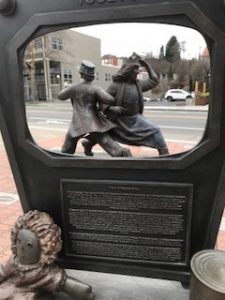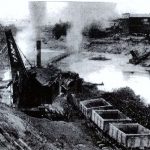Some Seattle-area neighborhoods, like Bothell, were named for early settlers. With the arrival of the Seattle, Lake Shore & Eastern Railroad in 1887, a railway station could give its name to the neighborhood.
Just north of Seattle’s Queen Anne hill, the Ross family had land claims on both sides of a stream called The Outlet, which flowed from Lake Union westward out to Puget Sound. The Ross family gave permission for the new railroad to come across their property and the railroad planners named a station in their honor. This caused the area to acquire “Ross” as a place name.
Ross was to the west of Fremont, bordered by 3rd Ave NW, and it included land on the south side of today’s ship canal. The earliest listings of “Seattle Seminary” (today’s Seattle Pacific University) in the City Directory of the 1890s gave its location as “Ross.” This also had to do with an actual post office for Ross, so that people could list it as their address.
The Ross Post Office opens in 1888
The coming of the SLS&E Railroad gave rise to more commercial development wherever a railway station was built. There was a general store and a Ross Post Office which opened on July 30, 1888, at 318 Ewing Street, on the south side of The Outlet. Today that address is on the west side of a canalside pocket park, near the present King County Wastewater building.
The first postmaster of Ross was Alfred J. Villars who had been born in 1843 in Clinton County, Ohio, and had served in the Union Army during the Civil War. As typical of many Civil War veterans, Alfred Villars married in 1865 after the war, and then the couple gradually moved westward across the USA. In 1888 Alfred & Harriet were listed in the Seattle City Directory as living in Ross where Alfred was postmaster. We know, however, that Harriet might have been the “default postmaster” because Alfred had another job. Perhaps this arrangement was not satisfactory, as another postmaster took over by the end of 1888.
Alfred Villars was a “title abstractor,” someone who researches property ownership so that sales of land can proceed without legal hang-ups. A title search ensures that there are no outstanding “encumbrances” such as liens against the property. This work would have meant that Alfred spent most of his time in the King County courthouse in downtown Seattle where records where kept.
In 1897 the Villars moved away from Ross when Alfred got a job at the downtown Seattle Public Library, where he worked for the next 23 years in the library’s “newspaper room.” In those days before radio, TV and the Internet, newspapers were vital sources of information. Newspapers were made available at the Seattle Public Library so that people could read them without a subscription.
The Ross Post Office closed in 1901. In 1902 the building at 318 Ewing was referred to as Old Post Office, in a list of polling places for elections.
Growth of Fremont outstrips Ross
Although both communities had a railroad stop, in the summer of 1888 the growth of Ross was eclipsed by that of Fremont. Fremont’s developers set up a lumber mill to help provide for housebuilding, and they advertised that the first hundred people to come to Fremont could buy a house lot for $1. Fremont, centered around today’s North 34th Street & Fremont Avenue where there was already a bridge across The Outlet, soon boomed with commercial and industrial growth. In contrast with Ross which was not a planned community, Fremont had developers who planned and organized for growth, including promotion of Fremont in real estate ads in the newspaper.
The Fremont Post Office opens in 1890
Fremont’s post office opened on March 25, 1890. Like the Ross Post Office, at first it operated out of a home on the south side of the existing Fremont Bridge, probably to get clear of the frenzy of building and lumber mill work on the north side of the bridge.
The first postmaster of Fremont was Thomas C. Ralston, someone who had only arrived in Seattle in 1888. He joined those going to Fremont for jobs in that first year of the community. Though he obtained the job of postmaster, it is likely that his wife Ida was the one who was doing that work from their home, while Thomas worked at the lumber mill in Fremont.
Death of the postmaster
Thomas Ralston’s term as Fremont postmaster was brief. At age 37 on August 11, 1892, Thomas received a fatal injury while he was unloading logs from rail cars, using a chute to let the logs slide down into the water, at the site of the Fremont lumber mill. The King County Death Register recorded that Thomas had been struck by a log so that he had an internal hemorrhage (bleeding).
A Ralston family letter of August 23, 1892, tells that they had heard from Sylvester “Sil” Ralston, brother of Thomas, what had happened to Tom:
“. . .You ask me if I had heard any more from Sil and if Tom was in Washington yet. Poor man. He is there but under the sod. He was killed the 11th day of this month while unloading logs out of rail cars into the lake. He had unloaded one car… the logs begun to roll down the chute and one of them struck him in the breast and knocked him into the water. There was but one man there with him. He was a car repairer. He got Tom out on the bank and asked him if he was badly hurt and if he should go to get some help. Tom said, I’ll be all right in a minute. The man soon asked him again and Tom made the same reply, but he then closed his eyes in unconsciousness. The man laid Tom back on the ground and went for help.
They took Tom home. The doctor said several ribs were broken, and Tom soon breathed his last. They put a subscription in circulation and realized $102.25. It took $75.00 to pay funeral expenses and the rest was given to his wife Ida. They had a petition going around asking that she be appointed postmistress in his place. It was being signed wherever it went.”
For the next year and a half, Ida Ralston was listed as postmistress at Fremont but it is likely that there was not enough income for her to support her family. She was now a widow with four daughters under nine years of age. In 1894 Ida moved to downtown Seattle where she successfully ran a lodging house.
Neighborhood names
At times when there were gaps of service of postmasters, mail for Fremont was directed to the post office of a neighboring community such as Ross or Edgewater. There was no home delivery of mail; people had to go to the post office to pick up letters. Newspapers often ran lists of names of people to let them know a letter was waiting for them.
Edgewater’s post office opened on May 20, 1889. The postmaster was William Ashworth who lived at the present site of the North Transfer Station, on North 34th Street just east of Stone Way. Like Ross, Edgewater was a railroad stop and a name for a community. These names didn’t “stick.” Today the former Ross area is referred to as North Queen Anne. The ship canal, completed in 1917, changed the landscape so that Fremont was defined as on the north side of the canal only.
The community names of Edgewater and Latona faded away as the name Wallingford gained in common use. Today Stone Way is considered to be the boundary between Fremont and Wallingford. Now the closest post office which serves the Fremont area is in Wallingford on North 47th Street just east of Stone Way.
Sources:
Fremont in Seattle: Street Names and Neighborhood Boundaries.
HistoryLink Essay #494, “Ross Post Office opens on July 30, 1888”, by Greg Lange, 1998.
HistoryLink Essay #508, “Fremont Post Office opens on March 25, 1890”, by Greg Lange, 1998.
Ross School in Fremont.
Street names lookup list: Seattle historian Rob Ketcherside has listed old and new street names in a search table. Most of the street names in Fremont were changed over time. Fremont Avenue, for example, was once called Lake. It was changed because more than one neighborhood was using that name. Beginning in 1895 the City of Seattle tried to rename streets for clarity and so that there would not be duplicate names.


